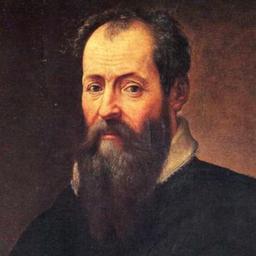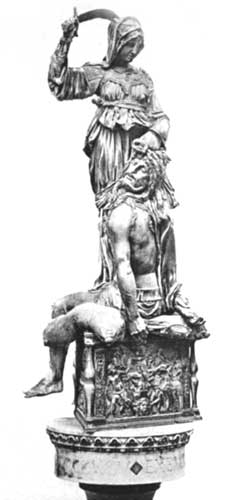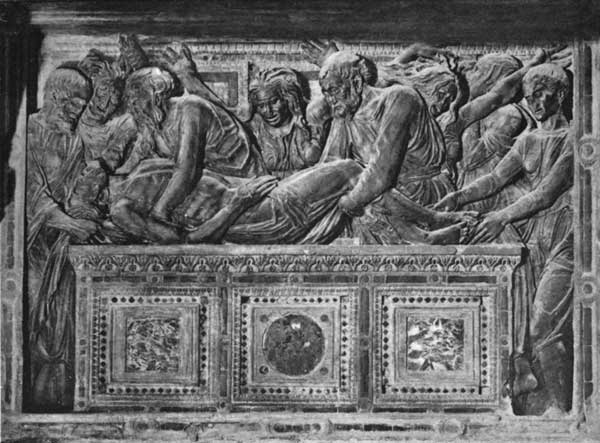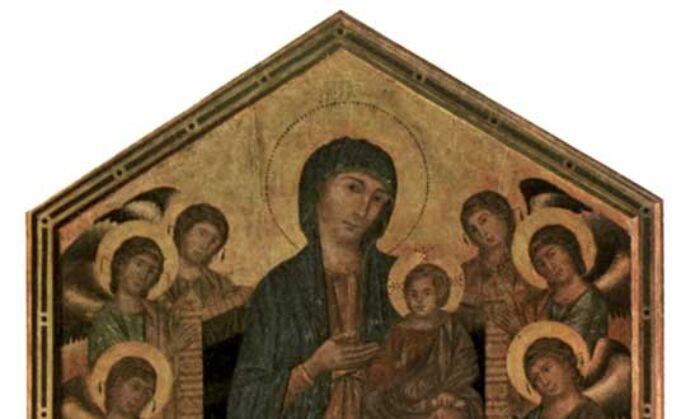Donato, who was called Donatello by his relatives and wrote his name thus on some of his works, was born in Florence in the year 1403. Devoting himself to the arts of design, he was not only a very rare sculptor and a marvellous statuary, but also a practised worker in stucco, an able master of perspective, and greatly esteemed as an architect; and his works showed so great grace, design, and excellence, that they were held to approach more nearly to the marvellous works of the ancient Greeks and Romans than those of any other craftsman whatsoever. Wherefore it is with good reason that he is ranked as the first who made a good use of the invention of scenes in low-relief, which he wrought so well that it is recognized from the thought, the facility, and the mastery that he showed therein, that he had a true understanding of them, making them with a beauty far beyond the ordinary; for not only did no craftsman in this period ever surpass him, but no one even in our own age has equalled him.
Donatello was brought up from his early childhood in the house of Ruberto Martelli, where, by his good qualities and by his zealous talent, he won the affection not only of Martelli himself but of all that noble family. As a youth he wrought many things, which were not held in great account, by reason of their number; but what made him known for what he was and gave him a name was an Annunciation in grey-stone, which was placed close to the altar of the Chapel of the Cavalcanti, in the Church of S. Croce in Florence. For this he made an ornament composed in the grotesque manner, with a base of varied intertwined work and a decoration of quadrantal shape, adding six boys bearing certain festoons, who appear to be holding one another securely with
their arms in their fear of the height. But the greatest genius and art that he showed was in the figure of the Virgin, who, alarmed by the unexpected apparition of the Angel, is making a most becoming reverence with a sweet and timid movement of her person, turning with most beautiful grace towards him who is saluting her, in a manner that there are seen in her countenance that humility and gratitude which are due to one who presents an unexpected gift, and the more when the gift is a great one. Besides this, Donato showed a masterly flow of curves and folds in the draperies of that Madonna and of the Angel, demonstrating with the suggestion of the nude forms below how he was seeking to recover the beauty of the ancients, which had lain hidden for so many years; and he displayed so great facility and art in this work, that nothing more could be desired, in fact, with regard to design, judgment, and mastery in handling the chisel.
In the same church, below the tramezzo,
[20] and beside the scene painted by Taddeo Gaddi, he made a Crucifix of wood with extraordinary care; and when he had finished this, thinking that he had made a very rare work, he showed it to Filippo di Ser Brunellesco, who was very much his friend, wishing to have his opinion. Filippo, whom the words of Donato had led to expect something much better, smiled slightly on seeing it. Donato, perceiving this, besought him by all the friendship between them to tell him his opinion; whereupon Filippo, who was most obliging, replied that it appeared to him that Donato had placed a ploughman on the Cross, and not a body like that of Jesus Christ, which was most delicate and in all its parts the most perfect human form that was ever born. Donato, hearing himself censured, and that more sharply than he expected, whereas he was hoping to be praised, replied, “If it were as easy to make this figure as to judge it, my Christ would appear to thee to be Christ and not a ploughman; take wood, therefore, and try to make one thyself.” Filippo, without another word, returned home and set to work to make a Crucifix, without letting anyone know; and seeking to surpass Donato in order not to confound his own judgment, after many months he brought it to the height of perfection. This
done, he invited Donato one morning to dine with him, and Donato accepted the invitation. Whereupon, as they were going together to the house of Filippo, they came to the Mercato Vecchio, where Filippo bought some things and gave them to Donato, saying, “Do thou go with these things to the house and wait for me there, I am coming in a moment.” Donato, therefore, entering the house and going into the hall, saw the Crucifix of Filippo, placed in a good light; and stopping short to study it, he found it so perfectly finished, that, being overcome and full of amazement, like one distraught, he spread out his hands, which were holding up his apron; whereupon the eggs, the cheese, and all the other things fell to the ground, and everything was broken to pieces. But he was still marvelling and standing like one possessed, when Filippo came up and said with a laugh, “What is thy intention, Donato, and what are we to have for dinner, now that thou hast upset everything?” “For my part,” answered Donato, “I have had my share for this morning: if thou must have thine, take it. But enough; it is thy work to make Christ and mine to make ploughmen.”
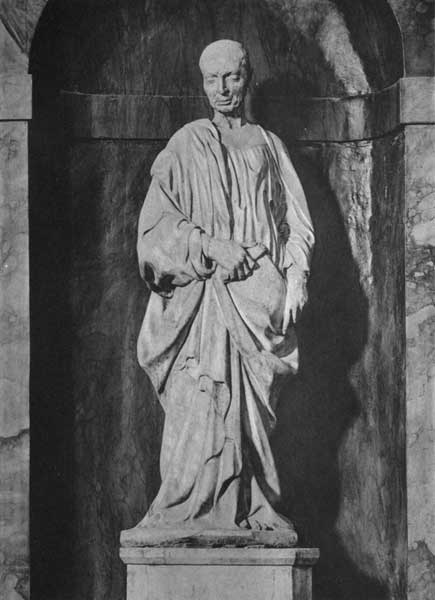
Poggio Bracciolini
(After Donatello. Florence: Duomo)
Alinari
In the Church of S. Giovanni in the same city Donato made a tomb for Pope Giovanni Coscia, who had been deposed from the Pontificate by the Council of Constance. This tomb he was commissioned to make by Cosimo de' Medici, who was very much the friend of the said Coscia. He wrought therein with his own hand the figure of the dead man in gilded bronze, together with the marble statues of Hope and Charity that are there; and his pupil Michelozzo made the figure of Faith. In the same church, opposite to this work, there is a wooden figure by the hand of Donato of S. Mary Magdalene in Penitence, very beautiful and excellently wrought, showing her wasted away by her fastings and abstinence, insomuch that it displays in all its parts an admirable perfection of anatomical knowledge. On a column of granite in the Mercato Vecchio there is a figure of Abundance in hard grey-stone by the hand of Donato, standing quite by itself, so well wrought that it is consummately praised by craftsmen and by all good judges of art. The column on which this statue is placed was formerly in S. Giovanni, where there are the others of granite supporting the gallery
within; it was removed and its place was taken by a fluted column, on which, in the middle of that temple, there once stood the statue of Mars which was taken away when the Florentines were converted to the faith of Jesus Christ. The same man, while still a youth, made a figure of the Prophet Daniel in marble for the façade of S. Maria del Fiore, and afterwards one of S. John the Evangelist seated, four braccia high, and clothed in a simple garment: which figure is much extolled. On one corner of the same place, on the side that faces towards the Via del Cocomero, there is an old man between two columns, more akin to the ancient manner than any other work that there is to be seen by the hand of Donato, the head revealing the thoughts that length of years brings to those who are exhausted by time and labour. Within the said church, likewise, he made the ornament for the organ, which stands over the door of the old sacristy, with those figures so boldly sketched, as it has been said, that they appear to the eye to have actual life and movement. Wherefore it may be said of this man that he worked as much with his judgment as with his hands, seeing that many things are wrought which appear beautiful in the rooms where they are made, and afterwards, on being taken thence and set in another place, in a different light or at a greater height, present a different appearance, and turn out the contrary to what they appeared; whereas Donato made his figures in such a manner, that in the room where he was working they did not appear half as good as they turned out to be in the positions where they were placed. For the new sacristy of the same church he made the design for those boys who uphold the festoons that go round the frieze, and likewise the design for the figures that were wrought in the glass of the round window which is below the cupola, namely, that one which contains the Coronation of Our Lady; which design is greatly superior to those of the other round windows, as it is clearly evident. For S. Michele in Orto in the said city he wrought the marble statue of S. Peter which is to be seen there, a most masterly and admirable figure, for the Guild of Butchers; and for the Guild of Linen-manufacturers he wrought the figure of S. Mark the Evangelist, which, after being commissioned to make it in company with Filippo Brunelleschi, he finished by himself with the consent of
Filippo. This figure was wrought by Donato with so great judgment that its excellence was not recognized, while it stood on the ground, by those who had no judgment, and the Consuls of that Guild were inclined to refuse to have it put into place; whereupon Donato besought them to let him set it on high, saying that he wished to work on it and to show them a different figure as the result. His request being granted, he covered it up for a fortnight, and then uncovered it without having otherwise touched it, filling everyone with wonder.
Judith
(After the bronze by Donatello. Florence: Loggia dei Lanzi)
Alinari
For the Guild of Armourers he made a most spirited figure of S. George in armour, in the head of which there may be seen the beauty of youth, courage and valour in arms, and a proud and terrible ardour; and there is a marvellous suggestion of life bursting out of the stone. It is certain that no modern figure in marble has yet shown such vivacity and such spirit as nature and art produced in this one by means of the hand of Donato. In the base that supports the shrine enclosing that figure he wrought in marble the story of the Saint killing the Dragon, in low-relief, wherein there is a horse that is much esteemed and greatly extolled; and in the frontal he made a half-length figure of God the Father in low-relief. Opposite to the church of the said oratory he wrought the marble shrine for the Mercatanzia, following the ancient Order known as Corinthian, and departing entirely from the German manner; this shrine was meant to contain two statues, but he refused to make them because he could not come to an agreement about the price. After his death these figures were made in bronze by Andrea del Verrocchio, as it will be told. For the main front of the Campanile of S. Maria del Fiore he wrought four figures in marble, five braccia in height, of which the two in the middle are portrayed from life, one being Francesco Soderini as a youth, and the other Giovanni di Barduccio Cherichini, now called Il Zuccone.
[21] The latter was held to be a very rare work and the most beautiful that Donato ever made, and when he wished to take an oath that would command belief he was wont to say, “By the faith that I place in my Zuccone”; and the while that he was working on it, he would keep gazing at it and saying, “Speak, speak,
plague take thee, speak!” Over the door of the campanile, on the side facing the Canon’s house, he made Abraham about to sacrifice Isaac, with another Prophet: and these figures were placed between two other statues.
For the Signoria of that city he made a casting in metal which was placed under an arch of their Loggia in the Piazza, representing Judith cutting off the head of Holofernes; a work of great excellence and mastery, which, if one considers the simplicity of the garments and aspect of Judith on the surface, reveals very clearly below the surface the great spirit of that woman and the assistance given to her by God, even as one sees the effect of wine and sleep in the expression of Holofernes, and death in his limbs, which have lost all life and are shown cold and limp. This work was so well executed by Donato that the casting came out delicate and very beautiful, and it was afterwards finished so excellently that it is a very great marvel to behold. The base, likewise, which is a baluster of granite, simple in design, appears full of grace and presents an aspect pleasing to the eye. He was so well satisfied with this work that he deigned to place his name on it, which he had not done on the others; and it is seen in these words, “Donatelli opus.” In the courtyard of the Palace of the said Signori there is a life-size David, nude and in bronze. Having cut off the head of Goliath, he is raising one foot and placing it on him, holding a sword in his right hand. This figure is so natural in its vivacity and its softness, that it is almost impossible for craftsmen to believe that it was not moulded on the living form. This statue once stood in the courtyard of the house of the Medici, but it was transported to the said place on the exile of Cosimo. In our own day Duke Cosimo, having made a fountain on the spot occupied by this statue, had it removed, and it is being kept for a very large courtyard that he intends to make at the back of the palace, that is, where the lions formerly stood. In the hall where there is the clock of Lorenzo della Volpaia, on the left, there is a very beautiful David in marble; between his legs, under his feet, he has the head of the dead Goliath, and in his hand he holds the sling wherewith he slew him. In the first courtyard of the house of the Medici there are
eight medallions of marble, wherein there are copies of ancient cameos and of the reverse sides of medals, with certain scenes, all made by him and very beautiful, which are built into the frieze between the windows and the architrave above the arches of the loggie. In like manner he restored an ancient statue of Marsyas in white marble, which was placed at the entrance of the garden; and a great number of ancient heads, which were placed over the doors, were restored and embellished by him with wings and diamonds (the emblem of Cosimo), wrought very well in stucco. He made a very lovely vessel of granite, which poured forth water, and he wrought a similar one, which also pours forth water, for the garden of the Pazzi in Florence. In the said Palace of the Medici there are Madonnas of marble and bronze made in low-relief, besides some scenes in marble with most beautiful figures, marvellous in their flat-relief. So great was the love that Cosimo bore to the talent of Donato that he kept him continually at work, and Donato, on the other hand, bore so great love to Cosimo that he could divine his patron’s every wish from the slightest sign, and obeyed him in all things.
It is said that a Genoese merchant caused Donato to make a lifesize head of bronze, which was very beautiful and also very light, because it had to be carried to a great distance; and that the commission for this work came to him through the recommendation of Cosimo. Now, when the head was finished and the merchant came to pay for it, it appeared to him that Donato was asking too much; wherefore the matter was referred to Cosimo, who had the head carried to the upper court of the palace and placed between the battlements that overlook the street, to the end that it might be seen better. When Cosimo sought to settle the difference, he found the offer of the merchant very far from the demand of Donato, and he turned round and said that it was too little. Whereupon the merchant, thinking it too much, said that Donato had wrought it in a month or little more, and that this meant a gain of more than half a florin a day. Donato, thinking this too much of an insult, turned round in anger and said to the merchant that in the hundredth part of an hour he would have been able to spoil the value of a year’s labour; and giving the head a push, he sent it flying straightway
into the street below, where it broke into a thousand pieces; saying to him that this showed that he was more used to bargaining for beans than for statues. Wherefore the merchant, regretting his meanness, offered to give him double the sum if he would make another; but neither his promises nor the entreaties of Cosimo could induce Donato to make it again. In the houses of the Martelli there are many scenes in marble and in bronze; among others, a David three braccia high, with many other works presented by him as a free gift to that family in proof of the devotion and love that he bore them; above all, a S. John of marble, made by him in the round and three braccia high, a very rare work, which is to-day in the house of the heirs of Ruberto Martelli. With regard to this work, a legal agreement was made to the effect that it should be neither pledged, nor sold, nor given away, without heavy penalties, as a testimony and token of the affection shown by them to Donato, and by him to them out of gratitude that he had learnt his art through the protection and the opportunities that he received from them.
He also made a tomb of marble for an Archbishop, which was sent to Naples and is in S. Angelo di Seggio di Nido; in this tomb there are three figures in the round that support the sarcophagus with their heads, and on the sarcophagus itself is a scene in low-relief, so beautiful that it commands infinite praise. In the house of the Count of Matalone, in the same city, there is the head of a horse by the hand of Donato, so beautiful that many take it for an antique. In the township of Prato he wrought the marble pulpit where the Girdle is shown, in which, in several compartments, he carved a dance of children so beautiful and so admirable, that he may be said to have demonstrated the perfection of his art no less in this work than in his others. To support this pulpit, moreover, he made two capitals of bronze, one of which is still there, while the other was carried away by the Spaniards who sacked that district.
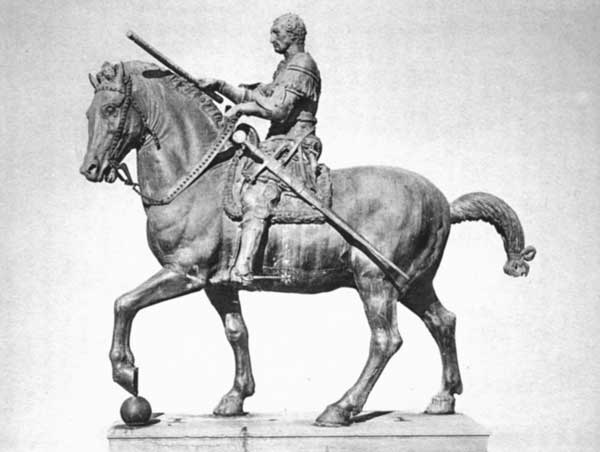
General Gattamelata
(After the bronze by Donatello. Padua: Piazzo di S. Antonio)
Anderson
It came to pass about this time that the Signoria of Venice, hearing of his fame, sent for him to the end that he might make the monument of Gattamelata in the city of Padua; wherefore he went there right willingly and made the bronze horse that is on the Piazza di S. Antonio,
wherein are perceived the panting and neighing of the horse, with great spirit and pride, most vividly expressed by his art, in the figure of the rider. And Donato proved himself such a master in the proportions and excellence of so great a casting, that he can truly bear comparison with any ancient craftsman in movement, design, art, proportion, and diligence; wherefore it not only astonished all who saw it then, but continues to astonish every person who sees it at the present day. The Paduans, moved by this, did their utmost to make him their fellow-citizen, and sought to detain him with every sort of endearment. In order to keep him in their midst, they commissioned him to make the stories of S. Anthony of Padua on the predella of the high-altar in the Church of the Friars Minor, which are in low-relief, wrought with so great judgment, that the most excellent masters of that art stand marvelling and amazed before them, as they consider their beautiful and varied compositions, with the great abundance of extraordinary figures and diminishing perspectives. Very beautiful, likewise, are the Maries that he made on the altar-dossal, lamenting the Dead Christ. In the house of one of the Counts Capodilista he wrought the skeleton of a horse in wood, which is still to be seen to-day without the neck; wherein the various parts are joined together with so much method, that, if one considers the manner of this work, one can judge of the ingenuity of his brain and the greatness of his mind. In a convent of nuns he made a S. Sebastian in wood at the request of a chaplain, a Florentine, who was their friend and an intimate of his own. This man brought him a figure of that Saint that they had, old and clumsy, beseeching him to make the new one like it. Wherefore Donato strove to imitate it in order to please the chaplain and the nuns, but, although he imitated it, clumsy as it was, he could not help showing in his own the usual excellence of his art. Together with this figure he made many others in clay and in stucco, and on one end of an old piece of marble that the said nuns had in their garden he carved a very beautiful Madonna. Throughout that whole city, likewise, there are innumerable works by his hand, by reason of which he was held by the Paduans to be a marvel and was praised by every man of understanding; but he determined to return
to Florence, saying that if he remained any longer in Padua he would forget everything that he knew, being so greatly praised there by all, and that he was glad to return to his own country, where he would gain nothing but censure, since such censure would urge him to study and would enable him to attain to greater glory. Having departed from Padua, therefore, he returned by way of Venice, where, as a mark of his friendliness towards the Florentine people, he made them a present of a S. John the Baptist, wrought by him in wood with very great diligence and study, for their chapel in the Church of the Friars Minor. In the city of Faenza he carved a S. John and a S. Jerome in wood, which are no less esteemed than his other works.
Afterwards, having returned to Tuscany, he made a marble tomb, with a very beautiful scene, in the Pieve of Montepulciano, and a lavatory of marble, on which Andrea Verrocchio also worked, in the Sacristy of S. Lorenzo in Florence; and in the house of Lorenzo della Stufa he wrought some heads and figures that are very spirited and vivacious. Then, departing from Florence, he betook himself to Rome, in order to try to imitate the antiques to the best of his ability; and during this time, while studying these, he made a tabernacle of the Sacrament in stone, which is to be seen in S. Pietro at the present day. Passing through Siena on his way back to Florence, he undertook to make a door of bronze for the Baptistery of S. Giovanni; and he had already made the wooden model, and the wax moulds were almost finished and successfully covered with the outer mould, ready for the casting, when there arrived, on his way back from Rome, one Bernardetto di Mona Papera, a Florentine goldsmith and an intimate friend of Donato, who wrought upon him so strongly both with words and in other ways, either for some business of his own or for some other reason, that he brought him back to Florence; wherefore that work remained unfinished, nay, not begun. There only remained in the Office of Works of the Duomo in that city a S. John the Baptist in bronze by his hand, with the right arm missing from the elbow downwards; and this Donato is said to have done because he had not been paid in full.
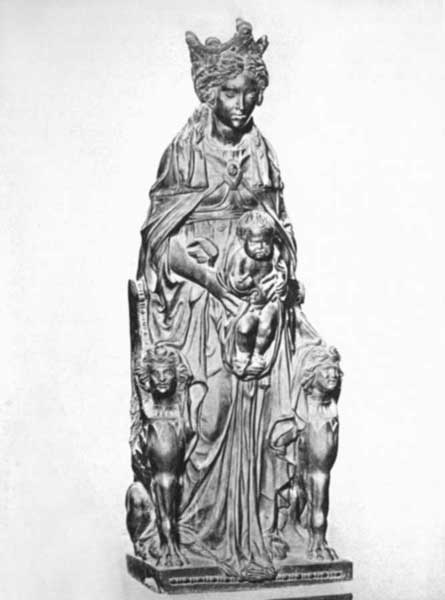
Madonna and Child
(After the bronze by Donatello. Padua: S. Antonio)
Anderson
Having returned to Florence, therefore, he wrought the Sacristy
of S. Lorenzo in stucco for Cosimo de‘ Medici, making four medallions on the pendentives of the vault containing stories of the Evangelists, with grounds in perspective, partly painted and partly in low-relief. And in the said place he made two very beautiful little doors of bronze in low-relief, with the Apostles, Martyrs, and Confessors; and above these he made some flat niches, one containing a S. Laurence and a S. Stephen, and the other S. Cosimo and S. Damiano. In the transept of the church he executed four saints in stucco, each five braccia high, which are wrought in a masterly manner. He also designed the bronze pulpits that contain the Passion of Christ, a work displaying design, force, invention, and an abundance of figures and buildings; but these his old age prevented him from executing, and his pupil Bertoldo finished them and brought them to the utmost perfection. For S. Maria del Fiore he made two colossal figures of brick and stucco, which are placed by way of ornament without the church, at the corners of the chapels. Over the door of S. Croce there is still to be seen a S. Louis wrought by him in bronze, five braccia high; for this someone criticized him, saying that it was stupid and perhaps the least excellent work that he had ever made, and he answered that he had made it so of set purpose, seeing that the Saint had been stupid to give up his throne and become a monk. The same man made the head of the wife of the said Cosimo de’ Medici in bronze, and this head is preserved in the guardaroba of the Lord Duke Cosimo, wherein there are many other works in bronze and marble by the hand of Donato; among others, a Madonna with the Child in her arms, sunk in the marble in flat-relief, which is the most beautiful work that it is possible to see, and the rather as it is surrounded by a border of scenes done in miniature by Fra Bartolommeo,
[22] which are admirable, as it will be told in the proper place. The said Lord Duke has a very beautiful, nay, miraculous Crucifix in bronze, by the hand of Donato, in his study, wherein there are innumerable rare antiquities and most beautiful medals. In the same guardaroba there is a bronze panel containing the Passion of Our Lord in low-relief,
with a great number of figures; and in another panel, also in metal, there is another Crucifixion. In like manner, in the house of the heirs of Jacopo Capponi, who was an excellent citizen and a true gentleman, there is a marble panel with the Madonna in half-relief, which is held to be a very rare work. Messer Antonio de‘ Nobili, who was Treasurer to his Excellency, had in his house a marble panel by the hand of Donato, in which there is a half-length Madonna in low-relief, so beautiful that the said Messer Antonio valued it as much as all his possessions; nor is it less valued by his son Giulio, a youth of singular goodness and judgment, a friend to lovers of art and to all men of excellence. In the house of Giovan Battista d’Agnol Doni, a gentleman of Florence, there is a Mercury of metal in the round by the hand of Donato, one braccio and a half in height and clothed in a certain bizarre manner; which work is truly very beautiful, and no less rare than the others that adorn his most beautiful house. Bartolommeo Gondi, of whom we have spoken in the Life of Giotto, has a Madonna in half-relief by the hand of Donato, wrought with so great love and diligence that it is not possible to see anything better, or to imagine the fancifulness which he gave to her headdress and the loveliness that he put into the garments which she is wearing. In like manner, Messer Lelio Torelli, First Auditor and Secretary to our Lord the Duke, and no less devoted a lover of all the honourable sciences, arts, and professions, than he is excellent as a jurist, has a marble panel of Our Lady by the hand of the same Donatello.
But if one were to give a complete account of his life and of the works that he made, it would be a far longer story than it is our intention to give in writing the Lives of our craftsmen, seeing that he put his hand not only to great things, of which there has been enough said, but also to the smallest things of art, making the arms of families on the chimneypieces and on the fronts of the houses of citizens, a most beautiful example of which may be seen in the house of the Sommai, which is opposite to that of the baker Della Vacca. For the family of the Martelli, moreover, he made a coffin in the form of a cradle wrought of wicker-work, to serve for a tomb; but it is beneath the Church of S. Lorenzo, because no tombs of any kind are to be seen above, save only the epitaph of the
tomb of Cosimo de' Medici, and even that one has its entrance below, like the others.
The Entombment
(After the relief by Donatello. Padua: S. Antonio)
Alinari
It is said that Simone, the brother of Donato, having wrought the model for the tomb of Pope Martin V, sent for Donato to the end that he might see it before it was cast. Going to Rome, therefore, Donato found himself in that city at the very moment when the Emperor Sigismund was there to receive the crown from Pope Eugenius IV; wherefore he was forced, in company with Simone, to occupy himself with making the magnificent preparations for that festival, whereby he acquired very great fame and honour.
In the guardaroba of Signor Guidobaldo, Duke of Urbino, there is a very beautiful head of marble by the hand of the same man, and it is believed that it was given to the ancestors of the said Duke by the Magnificent Giuliano de‘ Medici, at the time when he was staying at that Court, which was full of most cultured gentlemen. In short, the talent of Donato was such, and he was so admirable in all his actions, that he may be said to have been one of the first to give light, by his practice, judgment, and knowledge, to the art of sculpture and of good design among the moderns; and he deserves all the more commendation, because in his day, apart from the columns, sarcophagi, and triumphal arches, there were no antiquities revealed above the earth. And it was through him, chiefly, that there arose in Cosimo de’ Medici the desire to introduce into Florence the antiquities that were and are in the house of the Medici; all of which he restored with his own hand. He was most liberal, gracious, and courteous, and more careful for his friends than for himself; nor did he give thought to money, but kept his in a basket suspended by a cord from the ceiling, wherefore all his workmen and friends could take what they needed without saying a word to him. He passed his old age most joyously, and, having become decrepit, he had to be succoured by Cosimo and by others of his friends, being no longer able to work. It is said that Cosimo, being at the point of death, recommended him to the care of his son Piero, who, as a most diligent executor of his father’s wishes, gave him a farm at Cafaggiuolo, which produced enough to enable him to live in comfort. At this Donato made great
rejoicing, thinking that he was thus more than secure from the danger of dying of hunger; but he had not held it a year before he returned to Piero and gave it back to him by public contract, declaring that he refused to lose his peace of mind by having to think of household cares and listen to the importunity of the peasant, who kept pestering him every third day—now because the wind had unroofed his dovecote, now because his cattle had been seized by the Commune for taxes, and now because a storm had robbed him of his wine and his fruit. He was so weary and disgusted with all this, that he would rather die of hunger than have to think of so many things. Piero laughed at the simplicity of Donato; and in order to deliver him from this torment, he accepted the farm (for on this Donato insisted), and assigned him an allowance of the same value or more from his own bank, to be paid in cash, which was handed over to him every week in the due proportion owing to him; whereby he was greatly contented. Thus, as a servant and friend of the house of Medici, he lived happily and free from care for the rest of his life. When he had reached the age of eighty-three, however, he was so palsied that he could no longer work in any fashion, and took to spending all his time in bed in a poor little house that he had in the Via del Cocomero, near the Nunnery of S. Niccolò; where, growing worse from day to day and wasting away little by little, he died on December 13, 1466. He was buried in the Church of S. Lorenzo, near the tomb of Cosimo, as he had himself directed, to the end that his dead body might be near him, even as he had been ever near him in spirit when alive.
His death caused great grief to his fellow-citizens, to the craftsmen, and to all who knew him when living. Wherefore, in order to honour him more after death than they had done in his life, they gave him most honourable obsequies in the aforesaid church, and he was accompanied to the grave by all the painters, architects, sculptors, and goldsmiths, and by almost all the people of that city, which continued for a long time to compose in his honour various kinds of verses in diverse tongues, whereof it must suffice us to cite the few that are to be read below.
But before I come to the epitaphs, it will not be amiss to relate the following story of him as well. When he had fallen sick, and only a little before his death, certain of his relatives went to visit him; and after they had greeted him, as is customary, and condoled with him, they said that it was his duty to leave them a farm that he had in the district of Prato, although it was small and produced a very meagre income; and they prayed him straitly to do it. Hearing this, Donato, who showed something of the good in all that he did, said to them, “I cannot satisfy you, my kinsmen, because I intend to leave it—as it appears to me reasonable—to the peasant, who has always worked it and endured great labour thereby, and not to you, who, without having bestowed upon it anything more profitable than the thought of possessing it, expect me to leave it to you because of this your visit! Go, and may God bless you!” Of a truth such relatives, who have no love unconnected with advantage or with the hope of it, should be ever treated in this fashion. Sending therefore for a notary, he left the said farm to the labourer who had always worked it, and who perchance had behaved better to him in his need than those relatives had done. His art-possessions he left to his pupils, namely, Bertoldo, a sculptor of Florence, who imitated him closely enough, as may be seen from a very beautiful battle between men on horseback, wrought in bronze, which is now in the guardaroba of the Lord Duke Cosimo; Nanni d'Antonio di Banco, who died before him; and Rossellino, Desiderio, and Vellano da Padova. In short, it may be said that every man who has sought to do good work in relief since the death of Donato, has been his disciple. He was resolute in draughtsmanship, and he made his drawings with such mastery and boldness that they have no equals, as may be seen in my book, wherein I have figures drawn by his hand, both clothed and nude, animals that make all who see them marvel, and other most beautiful things of that kind. His portrait was made by Paolo Uccello, as it has been said in his Life. The epitaphs are as follows:
SCULTURA H.M. A FLORENTINIS FIERI VOLUIT DONATELLO, UTPOTE
HOMINI, QUI EI, QUOD JAMDIU OPTIMIS ARTIFICIBUS MULTISQUE SÆCULIS
TUM NOBILITATIS TUM NOMINIS ACQUISITUM FUERAT, INJURIAVE TEMPOR.
PERDIDERAT IPSA, IPSE UNUS UNA VITA INFINITISQUE OPERIBUS CUMULATISS.
RESTITUERIT: ET PATRIÆ BENEMERENTI HUJUS RESTITUTÆ
VIRTUTIS PALMAM REPORTARIT.
EXCUDIT NEMO SPIRANTIA MOLLIUS ÆRA;
VERA CANO; CERNES MARMORA VIVA LOQUI.
GRÆCORUM SILEAT PRISCA ADMIRABILIS ÆTAS
COMPEDIBUS STATUAS CONTINUISSE RHODON.
NECTERE NAMQUE MAGIS FUERANT HÆC VINCULA DIGNA
ISTIUS EGREGIAS ARTIFICIS STATUAS.
QUANTO CON DOTTA MANO ALLA SCULTURA
GIÀ FECER MOLTI, OR SOL DONATO HA FATTO;
RENDUTO HA VITA A' MARMI, AFFETTO, ED ATTO;
CHE PIÙ, SE NON PARLAR, PUÒ DAR NATURA?
The world remained so full of his works, that it may be affirmed right truly that no craftsman ever worked more than he did. For, delighting in every kind of work, he put his hand to anything, without considering whether it was of little or of great value. Nevertheless it was indispensable to sculpture, this vast activity of Donato in making figures in every kind of relief, full, half, low, and the lowest; because, whereas in the good times of the ancient Greeks and Romans it was by means of many that it became perfect, he alone by the multitude of his works brought it back to marvellous perfection in our own age. Wherefore craftsmen should trace the greatness of this art rather to him than to any man born in modern times, seeing that, besides rendering the difficulties of the art easy, in the multitude of his works he combined together invention, design, practice, judgment, and every other quality that ever can or should be looked for in a divine genius. Donato was very resolute and ready, executing all his works with consummate facility, and he always accomplished much more than he had promised.
He left all his work to be completed by his pupil Bertoldo, and particularly the bronze pulpits of S. Lorenzo, which were afterwards finished in great part by him, and brought to the state in which they are seen in the said church.
I will not forbear to say that the most learned and very reverend Don Vincenzo Borghini, of whom mention has been made above with regard to some other matter, has collected into a large book innumerable drawings by excellent painters and sculptors, both ancient and modern; and on the ornamental borders of two leaves opposite to each other,
which contain drawings by the hand of Donato and of Michelagnolo Buonarroti, he has written, with much judgment, these two Greek epigrams; on Donato’s, “[Greek: ê Dônatos Bonarhrôtizei],” and on Michelagnolo’s, “[Greek: ê Bonarhrôtos Dônatizei]”; which mean in Latin, “Aut Donatus Bonarrotum exprimit et refert; aut Bonarrotus Donatum,” and in our own tongue, “Either the spirit of Donato works in Buonarroto, or that of Buonarroto began by working in Donato.”


